Abstract
In this paper, the analysis of silicon oxynitride (SiON) films, deposited utilizing the plasma enhanced chemical vapor deposition (PECVD) process, for optical waveguides on silicon wafers is presented. The impact of N2O flow rate on various SiON film properties was investigated. The thickness and refractive index were measured by micro-spot spectroscopic reflectometry and confirmed by spectroscopic ellipsometry. The chemical composition of SiON films was analyzed using Secondary Ion Mass Spectrometry (SIMS). The surface roughness was analyzed using Atomic Force Microscopy (AFM). Increasing the N2O flow rate during deposition caused the deposition rate to increase and the refractive index to decrease. By changing the flow rate of gases into the chamber during the PECVD process, it is possible to precisely adjust the oxygen (O2) ratio and nitrogen (N2) ratio in the SiON film and thus control its optical properties. This was possibility utilized to fabricate SiON films suitable to serve as a waveguide core for optical waveguides with a low refractive index contrast.
1. Introduction
Integrated microwave photonics (IMWP) is a scientific field that uses optical devices and techniques to generate, process, control and distribute high-speed radiofrequency (microwave) signals. It has been at the center of interest of the research community for the past 30 years [1]. The primary areas of integrated microwave photonics applications are communication systems (cellular, wireless, and satellite), cable television, distributed antenna systems, optical signal processing, and the Internet of Things [2]. Integrated photonics not only makes it possible to reduce the footprint and complexity of microwave photonics systems, but offers much more. In the past years, the primary monolithic materials used for wafer-scale fabrication of integrated photonic devices have been III–IV (compound) semiconductors (InP, GaAs), element semiconductors (SOI—silicon-on-insulator), and dielectrics (silica and silicon nitride) [1].
Silicon oxynitride (SiON) is an attractive nonstoichiometric dielectric material with interesting properties for photonic applications. SiON films have variable parameters, ranging from silicon dioxide (SiO2) to silicon nitride (Si3N4). SiON films have lower mechanical stress [3], higher resistance to cracking than silicon nitride (Si3N4) [4], and better diffusion barrier properties [5]. The versatile properties of SiON films offer many possibilities of application in different fields, such as microelectronics [6,7], optoelectronics [7], integrated microwave photonics [1], or in the micro-electro-mechanical systems (MEMS) technology [8] as passivation layers [9,10], antireflective coatings (ARCs) [11], and multilayer interference coatings [12,13].
Deposition of the SiON film is possible through a wide range of different techniques, including plasma-enhanced chemical vapor deposition (PECVD) [5,9,10,11,14], low-pressure chemical vapor deposition (LPCVD) [5], pulsed magnetron sputtering (PMS) [13,15], ion-assisted deposition [16], radio-frequency sputtering deposition [8,12], ion-beam sputtering [17], and liquid source chemical vapor deposition (LSCVD) [18].
SiON waveguides have considerably lower refractive index contrasts than silicon-based (SOI) waveguides. SiON, as a core, has a refractive index in the range of n ≈ 1.45 to ≈ 2.1 (Si core has n ≈ 3.5) to a cladding layer (SiOx) with n ≈ 1.45. Therefore, SiON waveguides exhibit lower optical losses (0.01–0.6 dB/cm) [19,20,21] allowing much longer waveguides (delay lines). The physical properties of SiON films can be altered from SiO2 to Si3N4 by changing the chemical concentration of oxygen (O2) and nitrogen (N2) in the film. By changing the ratio of oxygen and nitrogen in the SiON waveguide, one can tune the refractive index in the range from ≈1.45 (SiO2) to ≈2.1 (Si3N4). This great flexibility of the refractive index selection allows for the construction of planar waveguides with a favorable compromise between compactness, comparable dimensions with telecommunication optical fibers, and possible variations for technological production processes [19]. This quality increases the attractiveness of this material for the preparation of photonic integrated circuits (PICs) for information and communication systems applications and optical sensing.
This paper is focused on the deposition and characterization of SiON films using various process parameters to obtain the suitable waveguide core for low refractive index contrast SiON waveguides. Based on simulations done by Chovan et al. [22], the goal is to deposit SiON films with a thickness of 2.5 µm and a refractive index of 1.6 for λ = 1.55 µm. The width of a SiON waveguide of 2.3 µm and the thickness of 2.5 µm are the largest dimensions the still maintain single-mode SiON waveguides [22] using the mentioned refractive index and wavelength.
2. Materials and Methods
SiON films were deposited by the PECVD technology process using a parallel plate configuration reactor (Plasmalab 80+, Oxford Instruments, Abingdon, UK). Standard 100 mm (4 in) polished Si wafers with (100) crystal orientation, the thickness of 525 ± 20 µm, and 100 nm of thermal oxide on the surface were used as substrates for the fabrication of the SiON films. This structure is shown in Figure 1a. Since the SiON film has a lower refractive index than the Si substrate, a sufficiently thick SiO2 layer is needed to prevent light from leaking into the Si substrate. However, for structural analysis of SiON film properties, only a 100 nm thick thermal SiO2 layer was used. Silicon wafers were cleaned in an ultrasonic bath with acetone, followed by ultrasonic cleaning in isopropyl alcohol and then rinsed with demi water before deposition. Precursor gas mixture for the deposition process contained silane (SiH4) (10% in Ar), nitrous oxide (N2O), and ammonia (NH3), all diluted in N2. The frequency of the PECVD reactor was set to 13.56 Mhz. Deposition temperature was set to 300 °C, base pressure to 1 Torr, and source power to 20 W. The values of SiH4(10%)/Ar, NH3, and N2 flow rates were set to 200, 20, and 600 sccm, respectively. The alteration of the SiON film parameters was achieved using variations of the N2O flow rate.
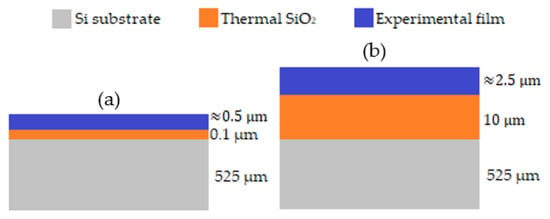
Figure 1.
(a) Model of the structure used in the SiON film analysis; (b) model of the structure with 2500 nm thick SiON film.
In order to analyze the refractive index and chemical composition of SiON films more accurately, SiN and SiOx films were also deposited by PECVD technology. For the deposition of the SiOx film, a standard recipe was used with a SiH4 flow rate set to 85 sccm and N2O flow rate set to 710 sccm. The deposition temperature, frequency, base pressure, and source power were the same as in the SiON film deposition. SiN film was prepared using a SiH4 flow rate of 200 sccm, an NH3 flow rate of 20 sccm, and an N2 flow rate of 300 sccm. The deposition temperature, frequency, base pressure, and source power were the same as in the SiON film deposition.
The thickness, uniformity, and refractive index of all samples were obtained using Micro-spot spectroscopic reflectometry (FilmTek 2000M, SCI, Carlsbad, CA, USA) and confirmed by spectroscopic ellipsometry (PhE-102, Angstrom Advanced Inc., Stoughton, MA, USA). The refractive index obtained by both methods was calculated using the Cauchy model. The deposition rates were calculated from the measured film parameters. The chemical composition of all films with a thickness of ≈500 nm was also analyzed by Secondary Ion Mass Spectrometry (SIMS IV, Ion-TOF, Münster, Germany) with liquid metal ion gun Bi+ operated at 25 keV and Cs+ ion sputtering operated at 2 keV in the dual-beam mode. Surface roughness was analyzed using Atomic Force Microscopy (AFM, XE-100, Park Systems, Suwon, Korea) in the tapping mode.
After structural analysis of the various SiON films with a thickness of ≈500 nm, a 2500 nm thick SiON film was deposited on a standard 100 mm (4 in) polished Si wafer with (100) crystal orientation, a thickness of 525 ± 20 µm, and 10 µm of thermal oxide on the surface. The model of this structure is shown in Figure 1b. The cleaning procedure before the deposition was the same as in the experiment above. The thickness, refractive index, and uniformities of thickness and refractive index of the deposited SiON film were analyzed by Micro-spot spectroscopic reflectometry (FilmTek 2000M, SCI, Carlsbad, CA, USA) using the SCI model. These films were not analyzed by spectroscopic ellipsometry because the measurements were highly inaccurate.
3. Results and Discussion
Figure 2a shows the deposition rate (nm/min) of the SiON film as a function of N2O flow rate resulting from micro-spot spectroscopic reflectometry measurements. The deposition rate of SiON films increases with increasing N2O flow rate causing more oxygen to be incorporated into the deposited film. It is known that the deposition rate of the SiOx films fabricated using the PECVD method is several times higher compared to the deposition rate of SiN films. Thus, it is to be expected that the increase of the N2O flow rate resulted in the higher deposition rate of the SiON film.
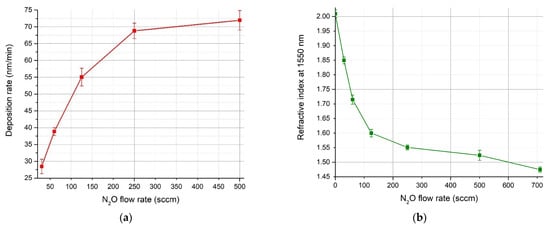
Figure 2.
(a) Deposition rate (nm/min) of the SiON film deposited by the PECVD technique as a function of N2O flow rate; (b) the dependence of the refractive index of SiON, SiN, SiOx films at a wavelength λ = 1550 nm on a N2O flow rate.
Figure 2b shows the refractive index dependence of SiON, SiN, and SiOx films at λ = 1550 nm on the N2O flow rate. It is apparent that the refractive index decreases with an increasing N2O flow rate and has an exponential character. This is explained by the fact that, during the deposition of SiON films utilizing the PECVD method, the most probable reaction is the formation of Si–O bonds. Therefore, even a slight increase of N2O flow rate, i.e., from 0 to 30 sccm, results in a significant decrease in the refractive index. It is also evident that the refractive index closest to the target value of n = 1.6 is for the SiON film deposited with N2O flow rate = 120 sccm.
The refractive index as a function of wavelength for SiN, SiOx, and SiON films is shown in Figure 3. Functions labeled as SION1–5 in Figure 3 represent SiON films deposited with N2O flow rate = 30, 60, 125, 250, and 500 sccm, respectively, as shown in Table 1. The values in the range from 1100 to 1600 nm were extrapolated from the measured data as the equipment does not allow the measurement in this range. From the analysis of the measured data, it follows that the refractive index of the deposited SiON films can be precisely controlled by the N2O flow rate. One can also assume that it is possible to increase the refractive index by increasing the NH3 flow rate. From the results of the analysis, the most suitable gas mixture for the fabrication of films with the target value of the refractive index n = 1.6 at λ = 1550 nm was the gas mixture of 200(SiH4):20(NH3):130(N2O):600(N2) sccm.
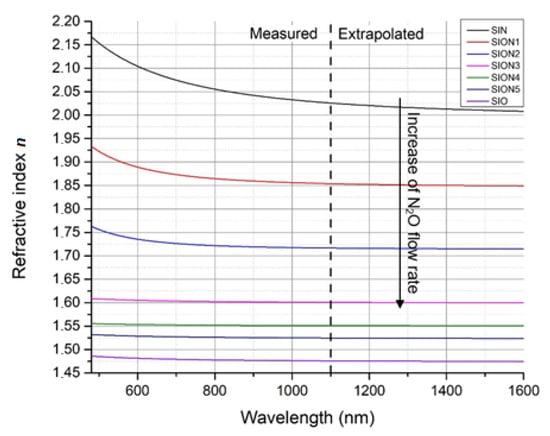
Figure 3.
Refractive index as a function of wavelength for SiN, SiOx, and SiON films acquired using the Cauchy model on the measured ellipsometry data.

Table 1.
RMS Surface roughness (nm) of SiN, SiO, and SiON films.
Figure 4a shows the SIMS analysis of the SiON film with an N2O flow rate of 30 sccm. In Figure 4a, the interface between the deposited SiON film and the thermal SiO2 film and between the thermal SiO2 film and the Si wafer is visible. The exponential growth of the intensity of all elements in the SiON film is caused by the change of material conductivity with the measurement depth. Unrelated elements with low intensity, i.e., sulfur (S-), nickel (Ni-), carbon (C-, C2-), and fluorine (F-), are not shown and can be disregarded. From the analysis of all samples, it is clear that the concentration of nitrogen-based elements (SiN-, SiNO- and SiNO2-) decreases with increasing N2O flow rate, and the concentration of oxygen based-elements (O-, O2-, SiO-, and SiO2-) increases with an increasing N2O flow rate, as expected. Furthermore, it has been confirmed that the Si–O bonds are dominant over the Si–N bonds in SiON film deposited utilizing the PECVD process. Additionally, the slow increase of deposition rate and a slight decrease of the refractive index at higher N2O flow rate is caused by saturation of O2 during the PECVD process. This also confirms the analysis of the refractive index and the deposition rate as functions of the N2O flow rate shown in Figure 2a,b.
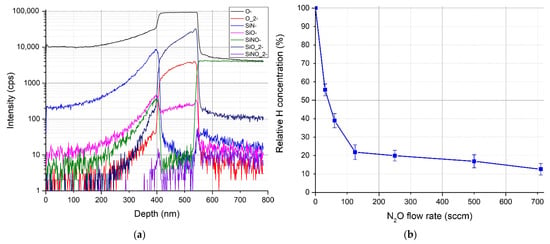
Figure 4.
(a) SIMS analysis of the SiON film with an N2O flow rate of 30 sccm; (b) relative hydrogen (H) concentration as a function of the N2O flow rate.
The standard growth process includes hydrogen as a component from SiH4 and NH3. The hydrogen itself is crucial from the absorption peak point of view at λ = 1550 nm. Therefore, it would be useful to estimate the hydrogen concentration level. One method of hydrogen concentration estimation is to compare the relative hydrogen concentration regarding the N2O flow rate. Figure 4b shows the relative concentration of hydrogen as a function of N2O flow rate, where 100% intensity is the intensity measured at an N2O flow rate of 0 sccm (Si3N4 sample). This behavior is not linear and decreases with the N2O flow rate increase, which is implicit since the overall concentration of gases that contain hydrogen (NH3, SiH4) decreases with a increasing N2O flow rate.
Figure 5a shows the dependence of the refractive index at λ = 1550 nm on the O/(O + N) concentration ratio. The blue squares represent the results acquired from SIMS measurements, and the line represents a calculation of refractive index according to the Bruggeman effective medium approximation method (EMA) [23,24] using the following equations:
where f1 and f2 are volume fractions of SiO2 and Si3N4 in the SiON film, respectively. Therefore, all oxygen in the SiON film is represented as SiO2, and all nitrogen is represented as Si3N4. The quantity n1 represents the refractive index of SiO2, n2 represents the refractive index of Si3N4, and n is the effective refractive index of SiON film. The value of n1 was taken as 1.46, and the value of n2 was 2 in the calculation. Equation (2) is used to convert the volume fraction ratio obtained by Equation (1) into the O/(O + N) concentration ratio. The factor of 1.3 stems from the difference between the atomic concentration of oxygen in SiO2 (4.64 × 1022 cm−3) and that of nitrogen in Si3N4 (5.88 × 1022 cm−3) [24]. From Figure 5a, it is evident that the refractive index decreases with increasing oxygen concentration in the SiON film, as expected. It is also apparent that the refractive index of SiON films calculated with Equations (1) and (2) is quite linear, and the agreement between measurements and calculation is satisfactory. A multiplication of 0.7×O was used as an ionization coefficient for oxygen in the O/(O + N) concentration ratio acquired from SIMS measurements. The other minor differences are caused by ellipsometry and SIMS measurement inaccuracies.
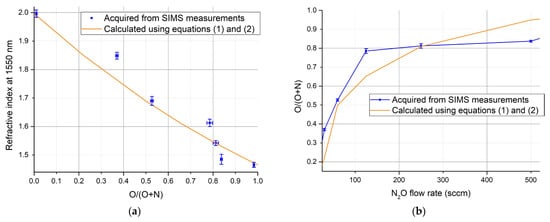
Figure 5.
(a) Dependence of refractive index at 1550 nm on the O/(O + N) concentration ratio; (b) the O/(O + N) concentration ratio of SiON films as a function of the N2O flow rate.
Figure 5b shows the comparison of the O/(O + N) concentration ratio resulting from the SIMS measurement and calculated using Equations (1) and (2) as a function of N2O gas flow rate. The O/(O + N) concentration ratio increases with the increasing ratio of the N2O flow rate. This is caused by the oversaturation of O at higher N2O flow rates. Since the oxygen ionizes easier during SIMS measurements, the O/(O + N) concentration ratio obtained from SIMS measurements is higher at lower N2O flow rates than the calculated values.
The root mean square (RMS) surface roughness of all films is shown in Table 1. It is evident that the N2O flow rate does not affect the RMS surface roughness. The lowest RMS surface roughness is at an N2O flow rate of 60 sccm, and the highest RMS surface roughness is at an N2O flow rate of 30 sccm. This RMS surface roughness should not introduce additional optical losses into the SiON waveguides. Even the highest RMS surface roughness measured is much lower than half of the wavelength of transmitted optical signal in the waveguide (1550/1.6 = 969/2 = 484.5 nm). The RMS surface roughness also influences the effective refractive index of SiON films at the interface. However, the RMS roughness below 100 nm is minor compared to the wavelength of propagating light. Therefore, the change of effective refractive index caused by the RMS surface roughness is insignificant and can be neglected.
After the analysis of SiON films with a thickness of ≈500 nm, a 2500 nm thick SiON film with tailored properties was deposited on a 10 µm thick thermal oxide, as mentioned in the section above. The thickness and the uniformity of thickness of the deposited SiON film were analyzed by Micro-spot spectroscopic reflectometry. However, the Cauchy model proved insufficient for the analysis because the difference between the measured and simulated spectral reflectance was too large. Therefore, Scientific Computing International (SCI) model was used for the analysis [25]. The SCI model is a generalization of the Lorentz oscillator model, where all oscillators are independent. In contrast, the SCI model allows for coupling between the oscillators. As the damping coefficient becomes zero, the SCI model converges to the Lorentz oscillator model. This physical coupling in the generalized model allows accurate simulation of metals, amorphous and crystalline semiconductors, and dielectric materials [25].
Figure 6a shows the measured and simulated spectral reflectance as a function of wavelength λ. The root mean square error (RMSE) between calculated and measured spectral reflectance is 1.9% which is acceptable. The AFM topography image of the analyzed SiON film is shown in Figure 6b. The size of the image is 10 × 10 µm2. In order to emphasize the surface roughness, the z-axis was magnified 20 times. The RMS surface roughness is approximately 5.32 ± 0.46 nm, which is much lower than the RMS surface roughness measured in the experiment above. One reason for the RMS roughness difference is that different substrates were used for samples with thick films. Another reason could be the technology itself. The RMS roughness below 100 nm is negligible for the waveguide operation, and the influence was not studied further.
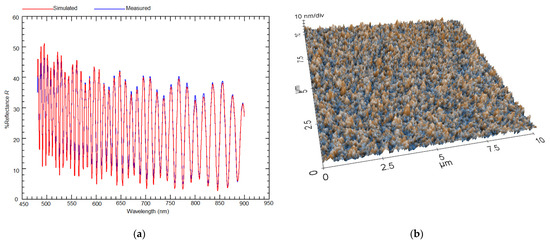
Figure 6.
(a) Measured and simulated reflectance R of a thick SiON film as a function of wavelength λ; (b) topography of 10 × 10 µm2 image of a thick SiON film.
Figure 7 shows the thickness and the uniformity of the thickness of SiON films on the whole wafer, where N is the number of points measured on the wafer. The thickness of SiON film is in the range of 2470–2522 nm, and the uniformity of thickness is ≈1.05%. The average thickness is ≈2505 nm, which is nearly identical to the thickness goal of 2500 nm. From Figure 7, it is evident that the thickness of the SiON film is the highest in the center of the wafer and decreases from the center to the edges of the wafer.
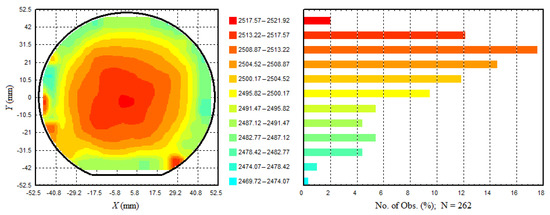
Figure 7.
Thickness and uniformity of thickness of a thick SiON film obtained by micro-spot spectroscopic reflectometry. N is the number of points measured on the wafer.
Figure 8 shows the distribution of refractive index of the SiON film at λ = 1550 nm on the whole wafer, where N is the number of points measured on the wafer. The distribution is relatively even, with only the edges of the wafer having a refractive index approximately 0.004 higher than the center of the wafer. The refractive index is in the range from n = 1.588 to n = 1.598 with an average value of n = 1.594. The uniformity of the refractive index is 0.3%. This value of the refractive index is relatively close to the desired value of n = 1.6. The difference is caused by the inaccuracies of the measurement. The extinction coefficient k is zero.
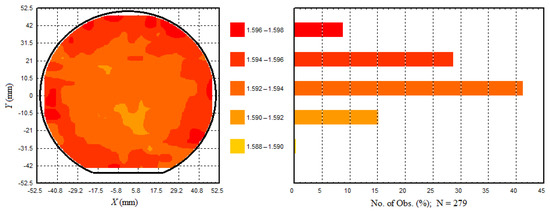
Figure 8.
Distribution of refractive index of a thick SiON film across a 100 mm wafer obtained by micro-spot spectroscopic reflectometry.
4. Conclusions
In this paper, the silicon oxynitride (SiON) films deposited utilizing the plasma-enhanced chemical vapor deposition (PECVD) process on silicon wafers were investigated. The impact of N2O flow rate on various SiON film properties was analyzed. The thickness and refractive index were measured by micro-spot spectroscopic reflectometry and confirmed by spectroscopic ellipsometry. The chemical composition of the films was analyzed using Secondary Ion Mass Spectrometry (SIMS). The surface roughness of the films was analyzed using Atomic Force Microscopy (AFM).
The deposition rate of SiON films increases, and the refractive index of SiON films decreases with an increasing N2O flow rate. This is explained by the fact that Si–O bonds are dominant over Si–N bonds in SiON film deposited utilizing the PECVD process. Additionally, the slow increase of deposition rate and a slight decrease of refractive index at a higher N2O flow rate are caused by saturation of O during the PECVD process. By changing the flow rate of gases into the chamber during the PECVD process, it is possible to precisely adjust the oxygen (O2) ratio and nitrogen (N2) ratio in the SiON film and thus control its optical properties.
This analysis was utilized to fabricate SiON film suitable to serve as a waveguide core for optical waveguides with lower refractive index contrast. A 2500 nm thick SiON film was deposited on a standard 100 mm (4 in) polished Si wafer with (100) crystal orientation, the thickness of 525 ± 20 µm, and 10 µm of thermal oxide on the surface. For the target value of the refractive index n = 1.6 at λ = 1550 nm, the gas mixture of 200(SiH4):20(NH3):130(N2O):600(N2) sccm was used. The thickness of SiON film is in the range of h = 2470–2522 nm with a uniformity of ≈1.05%. The average thickness is ≈2505 nm, which is nearly identical to the thickness goal of 2500 nm. The average surface roughness is approximately 5.32 ± 0.46 nm. The refractive index of SiON film for λ = 1550 nm is n = 1.593, matching the refractive index measured in the thin film analysis. Fabricated structure with 2500 nm thick SiON film on the surface with the aforementioned properties is eligible for the next steps in waveguide fabrication for the integrated photonics.
Author Contributions
Conceptualization, Ľ.P. and J.K.; methodology, investigation, resources, and data curation, Ľ.P., A.V., S.K. and J.C.; formal analysis, J.K.; writing—original draft preparation, Ľ.P.; writing—review and editing, J.K.; visualization, Ľ.P.; supervision, F.U.; project administration, and funding acquisition, J.K. and F.U. All authors have read and agreed to the published version of the manuscript.
Funding
This research was supported by the Science and Technology Assistance Agency under grant No. APVV-20-0437 and grant agency of Ministry of Education, Science, Research and Sport of the Slovak Republic under Grant No. VEGA 1/0733/20.
Institutional Review Board Statement
Not applicable.
Informed Consent Statement
Not applicable.
Data Availability Statement
The data presented in this study are available in this article.
Conflicts of Interest
The authors declare no conflict of interest.
References
- Marpaung, D.; Roeloffzen, C.; Heideman, R.; Leinse, A.; Sales, S.; Capmany, J. Integrated microwave photonics. Laser Photonics Rev. 2013, 7, 506–538. [Google Scholar] [CrossRef]
- Yi, X.; Chew, S.X.; Song, S.; Nguyen, L.; Minasian, R. Integrated microwave photonics for wideband signal processing. Photonics 2017, 4, 46. [Google Scholar] [CrossRef]
- Józwik, M.; Delobelle, P.; Gorecki, C.; Sabac, A.; Nieradko, L.; Meunier, C.; Munnik, F. Optomechanical characterization of compressively prestressed silicon oxynitride films deposited by plasma-enhanced chemical vapor deposition on silicon membranes. Thin Solid Films 2004, 468, 84–92. [Google Scholar] [CrossRef]
- Tan, X.; Wojcik, J.; Mascher, P. Study of the optical properties of SiOxNy thin films by effective medium theories. J. Vac. Sci. Technol. 2004, 22, 1115–1119. [Google Scholar] [CrossRef]
- Shim, J.; Yoon, H.G.; Na, S.-H.; Kim, I.; Kwak, S. Silicon oxynitride gas barrier coatings on poly(ether sulfone) by plasma-enhanced chemical vapor deposition. Surf. Coat. Technol. 2008, 202, 2844–2849. [Google Scholar] [CrossRef]
- Szekeres, A.; Nikolova, T.; Simeonov, S.; Gushterov, A.; Hamelmann, F.; Heinzmann, U. Plasma-assisted chemical vapor deposited silicon oxynitride as an alternative material for gate dielectric in MOS devices. Microelectron. J. 2006, 37, 64–70. [Google Scholar] [CrossRef]
- Kijaszek, W.; Oleszkiewicz, W.; Zakrzewski, A.; Patela, S.; Tłaczała, M. Investigation of optical properties of silicon oxynitride films deposited by RF PECVD method. Mater. Sci. 2016, 34, 868–871. [Google Scholar] [CrossRef]
- Liu, Y.; Lin, I.-K.; Zhang, X. Mechanical properties of sputtered silicon oxynitride films by nanoindentation. Mater. Sci. Eng. 2008, 489, 294–301. [Google Scholar] [CrossRef]
- Dupuis, J.; Fourmond, E.; Lelièvre, J.F.; Ballutaud, D.; Lemiti, M. Impact of PECVD SiON stoichiometry and post-annealing on the silicon surface passivation. Thin Solid Films 2008, 516, 6954–6958. [Google Scholar] [CrossRef]
- Hallam, B.; Tjahjono, B.; Wenham, S. Effect of PECVD silicon oxynitride film composition on the surface passivation of silicon wafers. Sol. Energy Mater. Sol. Cells 2012, 96, 173–179. [Google Scholar] [CrossRef]
- Wang, Y.; Cheng, X.; Lin, Z.; Zhang, C.; Zhang, F. Optimization of PECVD silicon oxynitride films for anti-reflection coating. Vacuum 2003, 72, 345–349. [Google Scholar] [CrossRef]
- Pinard, L.; Mackowski, J.M. Optical losses of multilayer stacks synthesized with silicon oxynitride by R.F. magnetron sputtering. Thin Solid Films 1998, 333, 126–133. [Google Scholar] [CrossRef]
- Lange, S.; Bartzsch, H.; Frach, P.; Goedicke, K. Pulse magnetron sputtering in a reactive gas mixture of variable composition to manufacture multilayer and gradient optical coatings. Thin Solid Films 2006, 506, 29–33. [Google Scholar] [CrossRef]
- Hiraki, T.; Aihara, T.; Nishi, H.; Tsuchizawa, T. Deuterated SiN/SiON waveguides on Si platform and their application to C-band WDM filters. IEEE Photonics J. 2017, 9, 1–7. [Google Scholar] [CrossRef]
- Tang, C.-J.; Jaing, C.-C.; Tien, C.-L.; Sun, W.-C.; Lin, S.-C. Optical, structural, and mechanical properties of silicon oxynitride films prepared by pulsed magnetron sputtering. Appl. Opt. 2017, 56, C168–C174. [Google Scholar] [CrossRef]
- Snyder, P.; Xiong, Y.-M.; Woollam, J.; Al-Jumaily, G.; Gagliardi, F. Graded refractive index silicon oxynitride thin film characterized by spectroscopic ellipsometry. J. Vac. Sci. Technol. 1992, 10, 1462–1466. [Google Scholar] [CrossRef][Green Version]
- Ray, S.K.; Das, S.; Maiti, C.K.; Lahiri, S.K.; Chakrabarti, N.B. Deposition of composition-controlled silicon oxynitride films by dual ion beam sputtering. Appl. Phys. Lett. 1991, 58, 2476–2478. [Google Scholar] [CrossRef]
- Jia, Y.; Dai, X.; Xiang, Y.; Fan, D. High quality factor silicon oxynitride optical waveguide ring resonators. Opt. Mater. 2018, 85, 138–142. [Google Scholar] [CrossRef]
- Yin, L.; Lu, M.; Wielunski, L.; Song, W.; Tan, J.; Lu, Y.; Jiang, W. Fabrication and characterization of compact silicon oxynitride waveguides on silicon chips. J. Opt. 2012, 14, 085501. [Google Scholar] [CrossRef][Green Version]
- Melati, D.; Morichetti, F.; Melloni, A. A unified approach for radiative losses and backscattering in optical waveguides. J. Opt. 2014, 16, 055502. [Google Scholar] [CrossRef]
- Bruno, F.; del Guidice, M.; Recca, R.; Testa, F. Plasma-enhanced chemical vapor deposition of low-loss SiON optical waveguides at 1.5-μm wavelength. Appl. Opt. 1991, 30, 4560–4564. [Google Scholar] [CrossRef] [PubMed]
- Chovan, J.; Figura, D.; Chlpík, J.; Lorenc, D.; Řeháček, V.; Uherek, F. Design, fabrication and characterization of SiOx/SiON/SiO2/Si structures for passive optical waveguides realization. Photonics Devices Syst. VII 2017, 10603, 106030N. [Google Scholar] [CrossRef]
- Bruggeman, D.A.G. Berechnung verschiedener physikalischer Konstanten von heterogenen Substanzen. I. Dielektrizitätskonstanten und Leitfähigkeiten der Mischkörper aus isotropen Substanzen. Ann. Phys. 1935, 416, 636–664. [Google Scholar] [CrossRef]
- Kuiper, A.E.T.; Koo, S.W.; Habraken, F.H.P.M. Deposition and composition of silicon oxynitride films. J. Vac. Sci. Technol. B 1983, 1, 62–66. [Google Scholar] [CrossRef]
- Scientific Computing International. FilmTek™ 2000M Operation Manual; Scientific Computing International: Carlsbad, CA, USA, 2016. [Google Scholar]
Publisher’s Note: MDPI stays neutral with regard to jurisdictional claims in published maps and institutional affiliations. |
© 2021 by the authors. Licensee MDPI, Basel, Switzerland. This article is an open access article distributed under the terms and conditions of the Creative Commons Attribution (CC BY) license (https://creativecommons.org/licenses/by/4.0/).